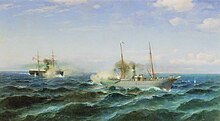Ottoman ironclad Feth-i Bülend
 Feth-i Bülend during repairs in Ansaldo factory.
| |
| History | |
|---|---|
| Name | Feth-i Bülend |
| Builder | Thames Iron Works, London |
| Laid down | May 1868 |
| Launched | 1869 |
| Commissioned | 1870 |
| Fate | Hulk in 1910, sunk by Greek torpedo boat in 1912 |
| General characteristics | |
| Class and type | Feth-i Bülend class |
| Displacement | 2,762 metric tons (2,718 long tons) |
| Length | 72 m (236 ft 3 in) (p.p.) |
| Beam | 11.9 m (39 ft 1 in) |
| Draft | 5.2 m (17 ft 1 in) |
| Installed power | |
| Propulsion |
|
| Speed | 13 knots (24 km/h; 15 mph) |
| Complement | 16 officers, 153 sailors |
| Armament | 4 × 229 mm (9 in) Armstrong guns |
| Armor | |
Feth-i Bülend (
Feth-i Bülend saw action during the
Design

Feth-i Bülend was 72.01 m (236 ft 3 in)
The ship was powered by a single horizontal
The ship was armed with a battery of four 222 mm (8.7 in) muzzle-loading Armstrong guns mounted in a central, armored casemate, two guns per side. The guns were positioned so as to allow any two to fire directly ahead, astern, or to either broadside. The casemate had heavy armor protection, with the gun battery protected by 222 mm of iron plating. The upper section of the casemate had thinner armor, at 150 mm (5.9 in) thick. The hull had a complete armored belt at the waterline, which extended 0.6 m (2 ft) above the line and 1.2 m (4 ft) below. The above-water portion was 222 mm thick, while the submerged part was 150 mm thick.[1][2]
Service history
Construction and the Russo-Turkish War
Feth-i Bülend, meaning "Great Victory",

Feth-i Bülend saw extensive service in the
Inactivity in the 1880s and 1890s
Following the Ottoman defeat in 1878, the ship was laid up in
The fleet remained inactive at the Golden Horn for twenty years, though in October 1889, Feth-i Bülend left the Golden Horn to escort the
Reconstruction and loss
Following the end of the war, the government decided to begin a naval reconstruction program. The first stage was to rebuild the older armored warships, including Feth-i Bülend. The Ottomans contacted several foreign shipyards; initially, Krupp's
At the outbreak of the
Footnotes
- ^ a b c Lyon, p. 390.
- ^ a b c d Langensiepen & Güleryüz, p. 138.
- ^ Langensiepen & Güleryüz, p. 198.
- ^ Langensiepen & Güleryüz, pp. 3, 5, 138.
- ^ Sturton, p. 138.
- ^ Langensiepen & Güleryüz, p. 6.
- ^ Sturton, pp. 138, 144.
- ^ a b Sturton, p. 144.
- ^ Langensiepen & Güleryüz, pp. 6–9.
- ^ Langensiepen & Güleryüz, pp. 10–11, 138.
- ^ Beehler, p. 12.
- ^ Langensiepen & Güleryüz, p. 19–20.
References
- Beehler, William Henry (1913). The History of the Italian-Turkish War: September 29, 1911, to October 18, 1912. Annapolis: United States Naval Institute. OCLC 1408563.
- Langensiepen, Bernd & Güleryüz, Ahmet (1995). The Ottoman Steam Navy 1828–1923. London: Conway Maritime Press. ISBN 978-0-85177-610-1.
- Lyon, Hugh (1979). "Turkey". In Gardiner, Robert (ed.). Conway's All the World's Fighting Ships 1860–1905. London: Conway Maritime Press. pp. 388–394. ISBN 978-0-85177-133-5.
- Sturton, Ian. "Through British Eyes: Constantinople Dockyard, the Ottoman Navy, and the Last Ironclad, 1876–1909". Warship International. 57 (2). Toledo: International Naval Research Organization. ISSN 0043-0374.
Further reading
- Silverstone, Paul H. (1984). Directory of the World's Capital Ships. New York: Hippocrene Books. ISBN 0-88254-979-0.
